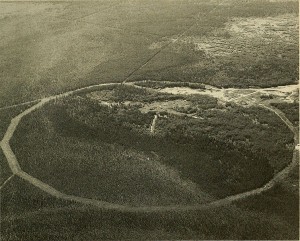Science Seen Physicist and Time One author Colin Gillespie helps you understand your world.
Four No Trump
Janet Mary Rogge Dugle
In memoriam
Jan Dugle was an American botanist. Black-spruce ecosystems were her special thing. I met her and her first husband David (whose trailblazing work with DNA I have mentioned) when I first arrived in North America. She soon sussed out my chief deficiency and set out to fix it: She taught me contract bridge.
Jan valued evidence. She thrived on facts, the more the better. Her magnum opus was a large-scale ecological experiment called FIG. Field Irradiator-Gamma measured long-term effects of low-level radiation on three boreal-forest  ecosystems. In its first year she and her crew of students examined plants and animals minutely in their seven-hundred-thousand square-meter site, with great care to not disturb it. Then they began years of irradiation from a gamma-ray source atop a central tower. Each year they would, with gamma rays screened off, examine the effects, recording every organism that the eye could see, one square meter at a time. That makes for lots of facts.
ecosystems. In its first year she and her crew of students examined plants and animals minutely in their seven-hundred-thousand square-meter site, with great care to not disturb it. Then they began years of irradiation from a gamma-ray source atop a central tower. Each year they would, with gamma rays screened off, examine the effects, recording every organism that the eye could see, one square meter at a time. That makes for lots of facts.
What she was after was not merely how different levels of radiation stressed each of the hundreds of species. Her question was how the relationships between species in each ecosystem adapted over time to the stress. And the answer? Using cutting-edge techniques to analyze huge amounts of data, her studies showed that relationships between species adapt to stress in complex and often counterintuitive ways. Her pioneering work has value today as we try to anticipate how the many ecosystems that sustain us will respond to a different source of stress – the local consequences of climate change.
As consequences multiply and costs increase, this is the kind of understanding that we will need in order to develop evidence-based policy. Jan was a true conservative. She knew that basing policy on evidence saves taxpayers’ money and offers some prospect of achieving the desired results.
Jan died in 2014 after a full life and career that were greatly extended by one of the earliest artificial heart valves. A product of American technological genius, it served her well until, long after its best-before date, it could no longer do its job.
Jan was, as good bridge players must be, a strategist. If some lie of the opposing cards, no matter how unlikely, was needed for success she would assume it. She had a unique bidding system but, as in standard Blackwood, her ‘four no trump’ asked partner to signal aces. Today, she would (to stretch my metaphor) be hoping to hear ‘five diamonds’. In other words, a to-her invisible ace.
Then I imagine that, optimistic as always, she would bid a grand slam.
Many miss her.
Image credit: Internet Archive Book Images, https://commons.wikimedia.org/wiki/File:The_Canadian_field-naturalist_%281983%29_%2820332378528%29.jpg

No comments yet.